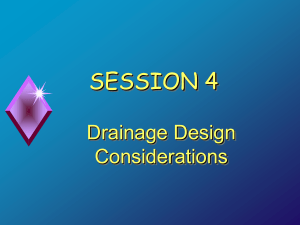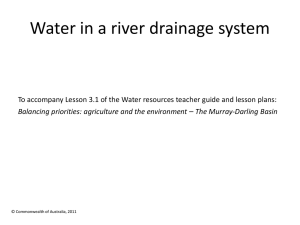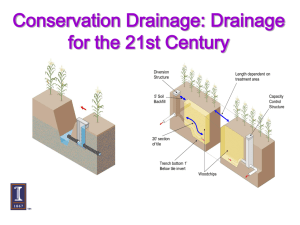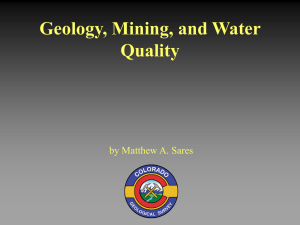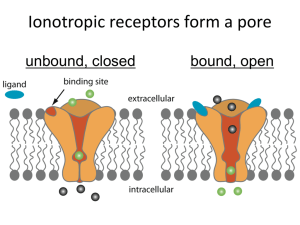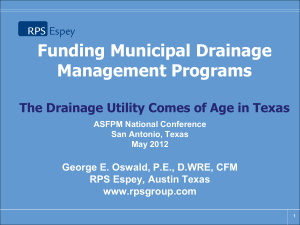Drainage Issues in the Landscape
advertisement
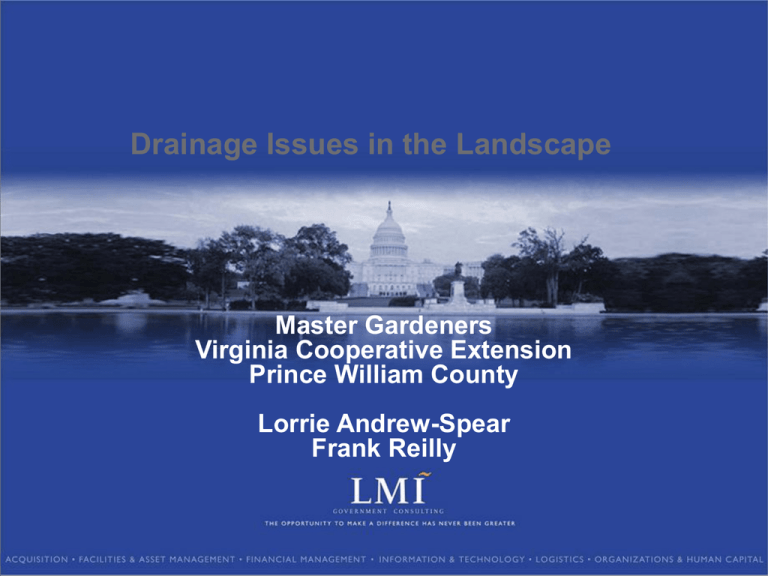
Drainage Issues in the Landscape Master Gardeners Virginia Cooperative Extension Prince William County Lorrie Andrew-Spear Frank Reilly Drainage Issues in the Landscape • A. Where does the water come from and why doesn’t it go away? • B. Impact of drainage problems • C. Drainage solutions • www.AdvancedMasterGardener.org PAGE 2 A. Where does the water come from and why it doesn’t go away • • • • Precipitation, ground water, surface water Watersheds Physiographic regions and soil types Soil texture and structure (particle sizes, pore spaces, well-drained soils vs. not, organic component, compaction) • Soil horizons and water infiltration • Run off (erosion, potential pollutants) PAGE 3 Precipitation, ground water, surface water PAGE 4 Groundwater – Surface Water PAGE 5 Run off affected by: •Impervious surfaces •Slope •Vegetation •Previous moisture •Infiltration rate PAGE 6 Run Off •Flooding •Erosion •Potential pollutants PAGE 7 Physiographic regions and soil types • Physiographic Regions describe land surface features • Closely related to geology • Slope, and soils are related PAGE 8 Physiographic Regions Appalachian Plateaus Valley and Ridge Blue Ridge Piedmont Plateau Coastal Plain PAGE 9 Soil Structure Granular Blocky Prismatic Platy Columnar Single Grained Massive P A G E 10 Soil Texture P A G E 11 Soil Texture •Sand are the largest particles and they feel "gritty." •Silt are medium sized, and they feel soft, silky or "floury." •Clay are the smallest sized particles, and they feel "sticky" and they are hard to squeeze. Sand 2.00 - 0.05 mm Silt 0.05 - 0.002 mm Clay < 0.002 mm P A G E 12 Pore Spaces •The smaller the particles •The smaller the pore spaces •Water moves slowly •Less air present P A G E 13 Pore Spaces can decrease due to compaction P A G E 14 Soil horizons and water infiltration •Horizons have different properties •Some may retard water flow •Watch out for the “builder’s horizon” P A G E 15 Check for Yourself •Dig a hole 12 inches deep and fill it with water •30 minutes, the soil has a drainage problem •24 hours, waterlogged soils may impact plant growth P A G E 16 Drainage Issues in the Landscape • A. Where does the water come from and why doesn’t it go away? • B. Impact of drainage problems • C. Drainage solutions P A G E 17 B. Impact of drainage problems • Home damage • Puddles (mud, mosquitoes) • Eroded topsoil, rills, gullies • Lawns and plants (stressed – drowned) P A G E 18 Impact of drainage problems Home Damage P A G E 19 Impact of drainage problems Puddles •Mosquitoes •Mud •Further damage P A G E 20 Impact of drainage problems Eroded topsoil, rills, gullies P A G E 21 Impact of drainage problems Erosion – Where do you think it goes? P A G E 22 Impact of drainage problems Lawns and plants (stressed drowned) P A G E 23 Impact of drainage problems • Damage at your home • Damage Down Stream – Watershed level – Neighborhood level • Keep the water safely on your property P A G E 24 Drainage Issues in the Landscape • A. Where does the water come from and why doesn’t it go away? • B. Impact of drainage problems • C. Drainage solutions • Drainage Options P A G E 25 Drainage Options 1. Horticultural ways to help wet soils 2. Slowing/intercepting Runoff 3. Slope/grading possibilities 4. Underground/subsurface alternatives P A G E 26 Drainage Options Horticultural Improvements • Soil • Plants • Mulch P A G E 27 Drainage Options Soils • Add compost – organic matter • Encourage earthworms/microorganisms • Aerate lawns • Avoid compaction P A G E 28 Drainage Options Plant Selection • “Wet Feet” • Erosion control – groundcovers on slopes • Native plants • Plant lists: - Extension Publications: Trees for Problem Landscape Sites: www.ext.vt.edu - Native plants for Conservation, Restoration and Landscaping (comprehensive list): www.dcr.state.va.us/dnh/native.htm P A G E 29 Native Plants • Group several of the same plant together to establish a healthy population. P A G E 30 Planting Wet Spots Plants Spiderwort Cardinal Flower Ferns P A G E 31 Plants for Wet Sites Plants •Royal fern, maidenhair fern, ostrich fern •Cardinal flower •Foam flower •Bleeding heart •Soloman’s seal •Butterfly weed •Columbine (native variety: Aquilegia canadensis) •Heavy metal switch grass P A G E 32 Plants Shrubs • Sweet pepperbush (Clethra alnifolia) • Red twig dogwood • Bush blueberry (Vaccinium corymbosum) • Inkberry holly (Ilex glabra) • Winterberry holly (Ilex vertilulata) • Arrowwood Viburnum (Viburnum dentatum) • Sweetspire (Itea virginica) • Red Chokeberry (Aronia abutifolia) P A G E 33 Planting Wet Spots Shrubs Sweetspire (Itea) Winterberry Holly Sweet Pepperbush (Clethra) PHOTOS: Floridata.com Sweetshrub (Calycarpa) (Ilex verticillata) P A G E 34 Plants Trees • River Birch (Betula nigra) • American Hornbeam (Carpinus carolinia) • American Holly (Ilex opaca) • Sweetbay Magnolia (Magnolia virginiana) • Tupelo (Nyssa sylvatica) • Swamp White Oak (Quercus bicolor) • Pussy Willow (Salix discolor) • Bald Cypress (Taxodium distichum) P A G E 35 Planting Wet Spots Trees Sweet Bay Magnolia American Holly River Birch PHOTOS: Floridata.com Hornbeam P A G E 36 Planting Wet Spots Odd Ball Plant collections P A G E 37 Need More? • Iris louisiana P A G E 38 Drainage Options Mulch • Organic – bark, shredded or “nuggets” – Different needs for drainage mulch! • Depth of 2-4 inches • Advantages – Breaks raindrops/prevents erosion – Aesthetic – Weed control • No volcanoes! P A G E 39 Drainage Options Slowing/intercepting Runoff • Gutters/downspouts, splashblocks/extenders • Rain Barrel/cistern • Rain garden P A G E 40 Drainage Options Gutters/downspouts – Leaf guard to prevent stoppages – Repair leaks – Check slope P A G E 41 Drainage Options Splashblocks/ extenders – Slope AWAY from foundation – Extend downspout: roll-out, perforated extension (above ground or buried); solid pipe – Drop inlet P A G E 42 Drainage Options Rain Barrels & Cisterns – above or underground P A G E 43 Roof Top Rainwater Harvesting P A G E 44 Rain Barrels have a number of uses! P A G E 45 Drainage Options Rain Gardens: Shallow landscaped areas built to slow down and hold rain runoff, allowing it to soak into the ground, instead of flowing into storm drains. P A G E 46 Rain Gardens: Commercial Use • Parking Lots • Neighborhood Common Areas, Parks, Schools • New Commercial Developments (LID) P A G E 47 Drainage Options Rain Garden Advantages • Prevent Erosion • Help prevent local (yard) flooding. • Soak up to 30% more water than lawns. • Prevent pollution P A G E 48 Where to Build a Rain Garden • Between area to be drained (roof, driveway or yard) and storm drain or street • Where downspout or other area can drain to it across a grassy area, or “filter strip” • At least 10 feet from your house’s foundation • An oval or oblong shape approximately 5-7% of the size of the area draining to it (roof, etc.) P A G E 49 Testing Drainage • Dig test hole • One foot deep • One foot long/wide • Fill with water until saturated • Fill again to top and let stand • If doesn’t drain in 24 hours, the site is not suitable for Rain Garden P A G E 50 Building Rain Gardens •Call Miss Utility!!! •Remove grass and 3-6+ inches of soil to make a level bottom. •Mix in compost, sand, topsoil, and other soil conditioners for better drainage. P A G E 51 Rain Gardens P A G E 52 Drainage Options Slope/re-grading possibilities • To slow and/or redirect flow of runoff But BEWARE: Don’t create more problems for yourself or your neighbors P A G E 53 Drainage Options Slope/grading possibilities – Filling low spots – Terracing slopes – Swales and berms – Dry creek beds P A G E 54 Drainage Options Filling low spots – If adding soil to low areas – be sure water has somewhere to go – Incorporate the new soil P A G E 55 Drainage Options Terracing Slopes – Prevents runoff erosion of slopes – Makes better planting beds – level, more stable P A G E 56 Building Terraces • • • • • • Height Materials Reinforcement Plants Mulch Terraces can work for drives too P A G E 57 Drainage Options Berms • Earthen mounds used to direct drainage (among other uses) • A site designer should evaluate the entire site’s drainage before considering a berm of significant size. P A G E 58 Drainage Options Swales: • Shallow earthen channels covered with grass P A G E 59 Building A Dry Creek Bed • Mimic stream’s shape – meander? • At least twice as wide as deep (good size is three feet wide by 18 inches deep) • Add rocks/plants • Lead to dispersal area or pond (NOT street) P A G E 60 Drainage Options Underground/subsurface alternatives • Hire Assistance for underground drainage options to ensure proper diversion and dispersal of water: – French Drain – Underground drainage system P A G E 61 Drainage Options French Drain • Gravel-filled trench • Perforated pipe • Covered with fabric • Slope to aid drainage • Call Miss Utility FIRST P A G E 62 Drainage Options Underground Drainage System • Hire a professional contractor qualified to create drainage systems. P A G E 63 BEST APPROACH • Use as many options as you can get from the tool box. P A G E 64 Questions? • www.AdvancedMasterGardener.org P A G E 65
